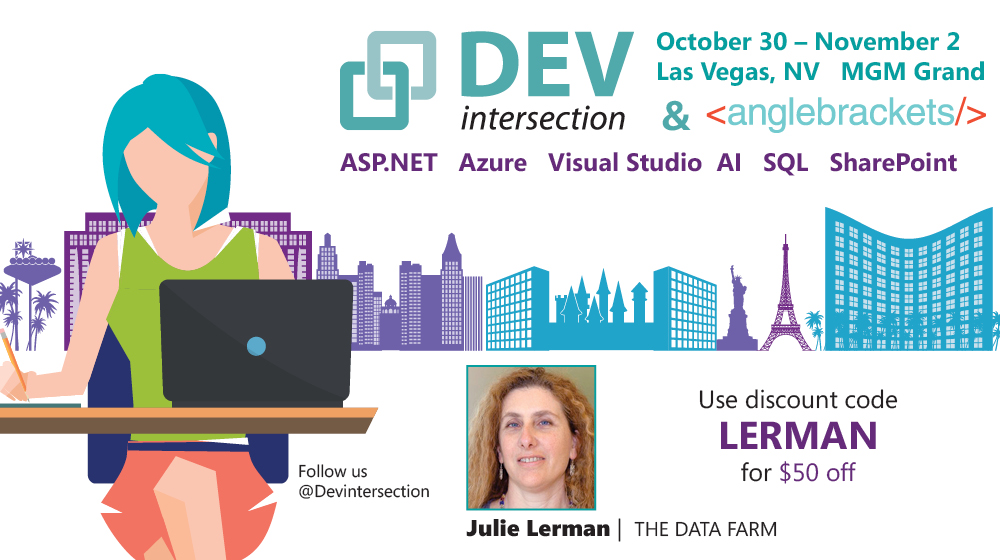Update: Pluralsight extended this for two more days if you missed this!
Good time to renew or finally get an annual subscription to Pluralsight. $100 off regular (so that’s $199) and premium ($349 after discount).
Update: Pluralsight extended this for two more days if you missed this!
Good time to renew or finally get an annual subscription to Pluralsight. $100 off regular (so that’s $199) and premium ($349 after discount).
All weekend, every course including my EF Core courses and Domain-Driven Design. Need to catch up on EF Core? Check out:
EF Core 2 Getting Started
EF Core 2 Mappings
EF Core 2.1: What’s New
But first you need to sign up for the free weekend!

If you are like me and design your classes following Domain-Driven Design principals , you may find yourself with code like this for controlling how objects get added to collections in the root entity.
public class Samurai {
public Samurai (string name) : this()
{
Name = name;
}
private Samurai ()
{
_quotes=new List<Quote>();
}
public int Id { get; private set; }
public string Name { get; private set; }
private readonly List _quotes = new List ()
private IEnumerable Quotes => _quotes.ToList ();
public void AddQuote (string quoteText) {
var newQuote=new Quote(quoteText,Id);
_quotes.Add (newQuote);
}
I have a fully encapsulated collection of Quotes. The only way to add a new quote is through the AddQuote method. You can’t just call Samura.Quotes.Add(myquote).
Additionally, because I want to control how developers interact with my API, there is no DbSet for Quotes. You have to do all of your queries and updates via context.Samurais.
A big downside to this is that if I have a new quote and I know the ID of the samurai, I have to first query for the samurai and then use the AddQuote. That really bugs me. I just want to create a new quote, push in the Samurai’s ID value and save it. And that requires either raw SQL or a DbSet<Quote>. I don’t like either option. Raw SQL is a hack in this case and DbSet<Quote> will open my API up to potential misuse.
I was thinking about this problem while laying in bed this morning (admit it, that’s the first thing you do when you wake up, too, right?) and had an idea.
In EF Core, we can now add objects directly to the context without going through the DbSet. The context can figure out what DbSet the entity belongs to and apply the right info to the change tracker. I thought this was handy for being able to call
myContext.AddRange(personobjectA, accountobjectB, productObjectC);
Although I haven’t run into a good use case for leveraging that yet.
What occurred to me is that if DbContext.Add is using reflection, maybe EF Core can find a private DbSet.
So I added a private DbSet to my DbContext class:
private DbSet<Quote> Quotes { get; set; }
static void AddQuoteToSamurai ()
{
using (var context =newSamuraiContext ())
{
var quote=newQuote("Voila",1);
context.Add(quote);
context.SaveChanges();
}
}
public void AddQuote (string quoteText)
{
Utilities.RemoveBadWords(quoteText);
var newQuote=new Quote(quoteText,Id);
_quotes.Add (newQuote);
}
public static Quote AddQuote(string quoteText,int samuraiId)
{
Utilities.RemoveBadWords(quoteText);
var newQuote=newQuote(quoteText,samuraiId);
return newQuote;
}
This works and now I don’t have to have an instance of Samurai to use it:
staticvoid AddQuoteToSamurai ()
{
using (var context =newSamuraiContext ()) {
context.Add(Samurai.AddQuote("static voila",1));
context.SaveChanges();
}
One thing I was worried about was if I had an instance of Samurai and tried to use this to add a quote to a different samurai. That would break the aggregate root…it’s job is to manage its own quotes only. It shouldn’t know about other Samurais.
But .NET protects me from that. I can’t call the static method from an instance of Samurai.
I still think that there’s a little bit of code smell from a DDD perspective about having this static, pass-through method in an aggregate root so will have to investigate that (or wait for any unhappy DDDers in my comments). But for now I am happy that I can avoid having to query for an instance of Samurai just to do this one task.
I have been away from home more than at home this fall! I have two trips behind me:
Trip 1: London for ProgNet, Salt Lake City for Pluralsight Live and Denver for Explore DDD.
Trip 2: Orlando for AngularMix then a side trip to Miami to visit friends and relatives
I’m home again for a bit then off again to Las Vegas for Devintersection. If you are still thinking about going (you should, really) you can still get a small discount using the code “LERMAN” when you register.
I will be giving 3 talks, participating in a panel and of course attending talks.
One for SURE that I’ll attend is on EF Core by two members of the team (and my friends!) Diego Vega and Andrew Peters on Tuesday.
I’m also doing an EF Core 2 talk which will be complementary to their session (not redundant) . That talk is on Wednesday morning.
Later on Wednesday I’m doing a session (should be FUN) for developers to take advantage of SQL Server in containers for quick dev environments. There I will show setting up and using a docker container with SQL Server for Linux (on my mac) and then a windows container for SQL Server Developer. For a dev or testing environment these are such fast and easy ways to spin up a SQL Server.
In my last session, which is on Thursday, I’m going to mostly code (yay! What is more fun that that?) to build up a data api and provide some design guidance at the same time as letting you get MORE eyeballs full of EF Core 2.0. And for a bonus, I finally got my hands on Azure Functions so I get to show off what I built on there as well.
After that, I’ll be on the closing panel. One NEVER knows what to expect there. Should be fun.
And also how cool is this graphic that the conference created, just for me to share just with you! 
Today was dedicated to updating my long running repository sample that I started when EF Core was EF 7 to the newest version of EF Core: 1.1. Here is the updated repo: https://github.com/julielerman/EFCore-ASPNetCore-WebAPI-RTM.
Phase one of this update continues to use project.json.
In addition to updating the version #s of the Nuget package references, I also made some changes to the code to reflect a few new features.
Pay attention to the tooling packages. In the tools section, the package name has changed – note DotNet at the end – and the version is currently 1.0.0-preview3 even though IIS version is preview2.
"tools": {
"Microsoft.AspNetCore.Server.IISIntegration.Tools":
"1.0.0-preview2-final",
"Microsoft.EntityFrameworkCore.Tools.DotNet":
"1.0.0-preview3-final"
},
Also in the dependencies, the EFCore Design package is 1.1.0 like the rest of EFCore. That’s part of the EF APIs, not tooling.
Code changes ….
You’ll discover the DbSet.Find method and change tracker Load method in use in the repository class. These were both added in to EF Core 1.1.
I modified the WeatherEvent class to fully encapsulate its Reactions collection using the support for mapping to IEnumerable. That resulted in some changes to constructors and the addition of an AddReaction method and a local variable.
Unrelated to EF Core, I also modified the SeedData.cs class. It reads a hard coded seeddata.json file to read in seed data. That data used old dates. I wanted the data to show current dates to help me tell that I really and truly pushed new data into the database. Since the Date property of WeatherEvent is private, they way I went about this was to read the raw JSON and update the date value that way then save the raw JSON back to the original file. Then I deserialize the JSON with a current range of dates into a set of WeatherEvents. This also means that I added Delete/Create database back in so the database gets thrown away and recreated/reseeded every time you start up the application.
The tests are also update to use the latest packages. In addition to changing the versions, I had to add a reference to an older package (InternalServices) as its dependency has not yet been updated in xunit.
Here’s the full project.json for the test project since I had to do a bunch of googling to figure it out.
{
"version": "3.0.0-*",
"description": "Tests for simple app using aspnetcore, efcore and
postgresql. developed and run on OSX.",
"authors": [ "Julie Lerman" ],
"testRunner": "xunit",
"dependencies": {
"Microsoft.EntityFrameworkCore.InMemory": "1.1.0",
"src": "3.0.0",
"xunit": "2.2.0-beta4-build3444",
"dotnet-test-xunit": "2.2.0-preview2-build1029",
"Microsoft.DotNet.InternalAbstractions":"1.0.0"},
"frameworks": {
"netcoreapp1.0": {
"dependencies": {
"Microsoft.NETCore.App": {
"type": "platform",
"version": "1.1.0"
}
},
"imports": [
"dnxcore50",
"portable-net45+win8"
]
}
}
}
I hope you find this repository useful to see EF Core 1.1 in action.
Oh and as per a tweet by Brad Wilson, I added SDK to my global.json file!
Pro-Tip: Your .NET Core projects should *always* have a global.json file with an SDK version in them.
ALWAYS.
— Brad Wilson (@bradwilson) November 21, 2016
Now I have to go learn about why this is important. Clearly it is!
Bio and Pictures as of April 2012
For Conferences, User Groups, etc.
[Longer Bio: 158 words, 1021 chars including spaces]
Julie Lerman is the leading independent authority on Microsoft’s ADO.NET Entity Framework and has been using and teaching the technology since its inception in 2006. Julie is the author of the highly acclaimed "Programming Entity Framework” book series from O’Reilly Media with recent editions on Code First (Dec 2011) and DbContext (Feb 2012) . She is well known in the .NET community as a Microsoft MVP, ASPInsider and INETA Speaker. She is a prolific blogger and a frequent presenter at technical conferences large and small around the world, such as TechEd and DevConnections. She also writes articles for many well-known technical publications, including the monthly Data Points column in MSDN Magazine. Julie keeps busy creating training videos for MSDN and Pluralsight.com.
Julia lives in Vermont where she has run the Vermont.NET User Group since 2002 and was a founding board member of the Vermont Software Developers Alliance. You can read her blog at www.thedatafarm.com/blog and her tweets at twitter.com/julielerman.
[Shorter Bio: 70 words, 454 chars including spaces]
Julie Lerman is a Microsoft MVP, .NET mentor and consultant who lives in the hills of Vermont. You can find Julie presenting on Entity Framework and other Microsoft .NET topics at user groups and conferences around the world. Julie blogs at thedatafarm.com/blog, is the author of the highly acclaimed "Programming Entity Framework” books, the MSDN Magazine Data Points column and popular videos on Pluralsight.com. Follow Julie on twitter at julielerman.
| julie_100x130.jpg | juliex400.jpg | JulieLermanGeekette.jpg |
 |
 |
 |
| 100w x 130h, 7kb | 400w x 442h, 32kb | 110w x 127h, 5kb |
I have larger, hi-res versions as well. Email me if you want them.